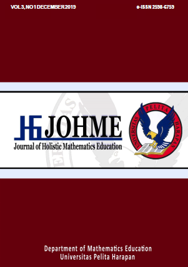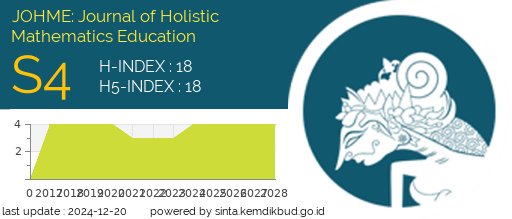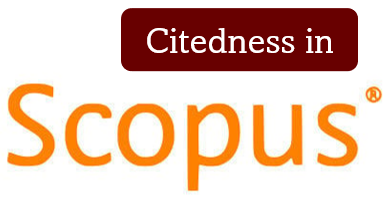UPAYA MENINGKATKAN KEMAMPUAN PEMECAHAN MASALAH SOAL NON-RUTIN PADA MATERI PERSAMAAN DAN PERTIDAKSAMAAN LINEAR SATU VARIABEL DENGAN PENERAPAN METODE PEER TUTORING [EFFORTS IN IMPROVING MATHEMATICAL PROBLEM-SOLVING SKILLS OF NON-ROUTINE PROBLEMS OF ONE-VARIABLE LINEAR EQUATIONS AND INEQUALITIES BY IMPLEMENTING THE PEER TUTORING METHOD]
DOI:
https://doi.org/10.19166/johme.v3i1.927Keywords:
peer tutoring, problem solving skills, non-routine, linear equation, kemampuan pemecahan masalah, non-rutin, persamaan linearAbstract
The purpose of learning mathematics is to obtain life skills through problem solving. Problem solving skills are one of mathematics skills that must be possessed by students. The result of the pre-cycle in this research showed that 83.33% of students had not achieved the minimum predicate “B-” in solving non-routine problems. It proved that students’ abilities in mathematics problem solving in non-routine problems were still low. During the pre-cycle, the researcher also observed some students who were not brave enough yet to ask questions of the teacher directly during the learning process. Besides that, almost all the students still had high individualistic and low awareness. Based on the problems that happened in the class, the researcher offered the peer tutoring method as a solution to improve students’ mathematical problem-solving skills in non-routine problems. The research method used in this research was Classroom Action Research using the Kemmis and McTaggart model. The instruments used in this research were tests, observation sheets, students’ questionnaires, and journal reflections. Based on the data analysis, students’ mathematical problem-solving skills in non-routine problems improved to 29.17% by implementing the peer tutoring method with the steps (1) choosing the tutors, (2) guiding the tutors, (3) students doing the tutoring activity, and (9) evaluating the learning process
BAHASA INDONESIA ABSTRAK: Tujuan dari mempelajari matematika ialah untuk memperoleh kecakapan hidup salah satunya melalui pemecahan masalah. Kemampuan pemecahan masalah merupakan salah satu standar kemampuan matematika yang harus dimiliki oleh siswa. Hasil tes pra siklus pada penelitian ini menunjukkan sebanyak 83.33% siswa belum mampu mencapai predikat minimal ”˜B-’ dalam menyelesaikan soal non-rutin. Ini membuktikan bahwa kemampuan pemecahan masalah matematis siswa pada soal non-rutin masih kurang. Selama pra siklus berlangsung, peneliti juga mengamati beberapa siswa belum berani untuk bertanya langsung kepada guru selama proses pembelajaran berlangsung. Selain itu, sebagian besar siswa masih memiliki sikap individualis yang tinggi dan juga rasa kepedulian antar siswa masih rendah. Berdasarkan masalah yang terjadi di dalam kelas tersebut maka peneliti menawarkan metode peer tutoring sebagai solusi untuk meningkatkan kemampuan pemecahan masalah matematis siswa pada soal non-rutin. Metode penelitian yang digunakan adalah Penelitian Tindakan Kelas dengan model Kemmis dan Mc. Taggart. Instrumen yang digunakan pada penelitian ini adalah tes, lembar observasi, angket siswa dan jurnal refleksi. Berdasarkan analisis data, kemampuan pemecahan masalah matematis siswa pada soal non-rutin mengalami peningkatan hingga 29,17% menggunakan metode peer tutoring dengan langkah-langkah penerapan yaitu (1) memilih tutor, (2) membimbing tutor, (3) siswa melakukan kegiatan tutorial, dan (4) mengevaluasi pembelajaran
References
Adjie, N., & Maulana. (2009). Pemecahan masalah matematika. Bandung, Indonesia: UPI Press.
Alamsyah. (2013). Prosiding dari Seminar Nasional Ilmu Komputer: Pengelolaan tutor sebaya bidikmisi Unnes berbasis web. Semarang, Indonesia: Universitas Negeri Semarang.
Alawiyah, T. (2017). Prosiding dari Seminar Nasional Matematika dan Pendidikan Matematika (SESIOMADIKA): Pengaruh metode pembelajaran tutor sebaya untuk meningkatkan kemampuan representasi matematis siswa SMP. Karawang, Indonesia: Fakultas Keguruan dan Ilmu Pendidikan Universitas Singaperbangsa.
Anas, M. (2014). Mengenal metode pembelajaran. Pasuruan, Indonesia: CV. Pustaka Hulwa.
Arifani, N. H., As’ari, A. R., & Abadyo. (2016). Prosiding dari Seminar Nasional Matematika dan Pendidikan Matematika UNY: Analisis kesalahan siswa dalam menyelesaikan soal matematika TIMSS menurut teori Newman: Studi kasus pada siswa kelas VIII SMP Negeri 1 Tanjungbumi Bangkalan. Yogyakarta, Indonesia: UNY Press.
Elia, I., Heuvel-Panhuizen, M., & Kolovou, A. (2009). Exploring strategy use and strategy flexibility in non-routine problem solving by primary school high achievers in mathematics. ZDM, 41(5), 605-618. https://doi.org/10.1007/s11858-009-0184-6
Holisin, I., ”˜Ainy, C., & Kristanti, F. (2017). Prosiding dari Seminar Nasional Matematika dan Aplikasinya: Pembelajaran pemecahan masalah matematika di sekolah dasar dengan model pembelajaran OSCAR. Surabaya, Indonesia: Universitas Airlangga.
NCTM. (2000). Executive Summary: Principles and standards for school mathematics. Reston, VA: National Council of Teachers of Mathematics. Retrieved from https://www.nctm.org/uploadedFiles/Standards_and_Positions/PSSM_ExecutiveSummary.pdf
Mikrayanti. (2016). Meningkatkan kemampuan penalaran matematis melalui pembelajaran berbasis masalah. Suska Journal of Mathematics Education, 2(2), 97-102. https://doi.org/10.24014/sjme.v2i2.1547
Mullis, I. V., Martin, M. O., Foy, P., & Hooper, M. (2016). TIMSS 2015: International results in mathematics. Chestnut Hill, MA: IEA Publisher.
Nissa, I. C. (2015). Pemecahan masalah matematika: Teori dan contoh praktek. Lombok, Indonesia: Duta Pustaka Ilmu.
Prakitipong, N., & Nakamura, S. (2006). Analysis of mathematics performance of grade five students in Thailand using Newman procedure. Journal of International Cooperation in Education, 9(1), 111-122. Retrieved September 17, 2017 from http://home.hiroshima-u.ac.jp/cice/wp-content/uploads/publications/Journal9-1/9-1-9.pdf
Rahmawati. (2016). Hasil TIMSS 2015: Diagnosa hasil untuk perbaikan mutu dan peningkatan capaian. Jakarta, Indonesia: Pusat Penilaian Pendidikan.
Sani, R. A. (2014). Inovasi pembelajaran. Jakarta, Indonesia: Bumi Aksara.
Santoso, D. A., Farid, A., & Ulum, B. (2017). Error analysis of students working about word problem of linear program with NEA procedure. Journal of Physics: Conference Series, 855(1), 1-8. https://doi.org/10.1088/1742-6596/855/1/012043
Shadiq, F. (2009). Kemahiran Matematika. Yogyakarta, Indonesia: Depdiknas.
Singh, P., Rahman, A. A., & Hoon, T. S. (2010). The Newman procedure for analyzing primary four pupils errors on written mathematical tasks: A malaysian perspective. Procedia - Social and Behavioral Sciences, 8, 264-271. https://doi.org/10.1016/j.sbspro.2010.12.036
Sudibjo, N., & Simanjuntak, M. F. (2019). Meningkatkan keterampilan berpikir kritis dan kemampuan memecahkan masalah siswa melalui pembelajaran berbasis masalah. JOHME: Journal of Holistic Mathematics Education, 2(2), 108-118. https://doi.org/10.19166/johme.v2i2.1331
Sumartini, T. S. (2018). Peningkatan kemampuan pemecahan masalah matematis siswa melalui pembelajaran berbasis masalah. Mosharafa: Jurnal Pendidikan Matematika, 5(2), 148-158. https://doi.org/10.31980/mosharafa.v5i2.270
Yulianto, & Sutiarso, S. (2017). Prosiding dari Seminar Nasional Matematika dan Pendidikan Matematika: Meningkatkan kemampuan komunikasi dan pemecahan masalah dalam pembelajaran matematika. Lampung, Indonesia: Prodi Pendidikan Matematika FTK IAIN Raden Intan Lampung.Downloads
Published
How to Cite
Issue
Section
License
Authors who publish with this journal agree to the following terms:
1) Authors retain copyright and grant the journal right of first publication with the work simultaneously licensed under a Creative Commons Attribution License (CC-BY-SA 4.0) that allows others to share the work with an acknowledgement of the work's authorship and initial publication in this journal.
2) Authors are able to enter into separate, additional contractual arrangements for the non-exclusive distribution of the journal's published version of the work (e.g., post it to an institutional repository or publish it in a book), with an acknowledgement of its initial publication in this journal.
3) Authors are permitted and encouraged to post their work online (e.g., in institutional repositories or on their website). The final published PDF should be used and bibliographic details that credit the publication in this journal should be included.”










